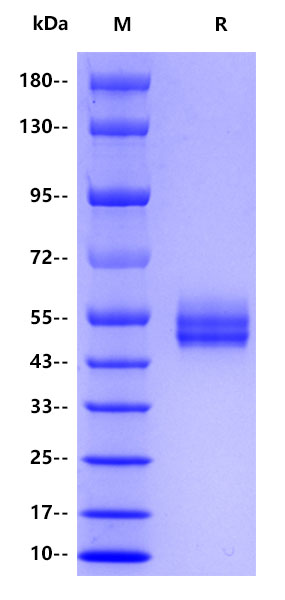

 下载产品说明书
下载产品说明书 用小程序,查商品更便捷
用小程序,查商品更便捷



 收藏
收藏
 对比
对比 咨询
咨询Protein sequence (P33705, Val25-Lys401, with C-10*His) VREVVLGKAGDAVELPCQTSQKKNIHFNWRDSSMVQILGNQGSFWTVGSSRLKHRVESKKNLWDQGSFPLVIKDLEVADSGIYFCDTDKRQEVELLVFNLTAKWDSGSSSGSSNIRLLQGQQLTLTLENPSGSSPSVQWKGPGNKSKHGGQNLSLSWPELQDGGTWTCIISQSQKTVEFNINVLVLAFQKVSNTFYAREGDQVEFSFPLSFEDENLVGELRWQAQGASSSLLWISFTLENRKLSMKEAHAPLKLQMKESLPLRFTLPQVLSRYAGSGILTLNLAKGTLYQEVNLVVMRANSSQNNLTCEVLGPTSPELTLSLNLKEQAAKVSKQQKLVWVVDPEGGTWQCLLSDKDKVLLASSLNVSSPVVIKSWPKGGGGSHHHHHHHHHH








| \n 2μg(R: reducing\n conditions) \n | \n
\n\n\n\n\n\n


CD4 (cluster of differentiation 4) is a glycoprotein that serves as a co-receptor for the T-cell receptor (TCR). CD4 is found on the surface of immune cells such as T helper cells, monocytes, macrophages, and dendritic cells. It was discovered in the late 1970s and was originally known as leu-3 and T4 (after the OKT4 monoclonal antibody that reacted with it) before being named CD4 in 1984. CD4+ T helper cells are white blood cells that are an essential part of the human immune system. They are often referred to as CD4 cells, T-helper cells or T4 cells. They are called helper cells because one of their main roles is to send signals to other types of immune cells, including CD8 killer cells, which then destroy the infectious particle.


12 months from date of receipt, -20 to -70 °C as supplied. 6 months, -20 to -70 °C under sterile conditions after reconstitution. 1 week, 2 to 8 °C under sterile conditions after reconstitution. Please avoid repeated freeze-thaw cycles.
参考图片
|
2μg(R: reducing conditions) |







 危险品化学品经营许可证(不带存储) 许可证编号:沪(杨)应急管危经许[2022]202944(QY)
危险品化学品经营许可证(不带存储) 许可证编号:沪(杨)应急管危经许[2022]202944(QY)  营业执照(三证合一)
营业执照(三证合一)